Western Sydney University: Health Variations 3 - Mrs. Brown Case Study
VerifiedAdded on 2022/10/14
|8
|1871
|10
Report
AI Summary
This report presents a comprehensive analysis of Mrs. Brown's case, who is suffering from acute shortness of breath and chronic respiratory disease, with a focus on the pathogenesis of her clinical manifestations. The report details her symptoms, including severe dyspnea and the presence of bilateral basal cracks, linking these to potential causes such as heart failure and atrial fibrillation. It explores the role of aging and other organ system diseases in her condition. Nursing interventions, including oxygen therapy, breathing exercises, patient counseling, and medication management (Furosemide and sublingual glycerol trinitrate), are discussed to manage her condition. The report also explains the mechanism of action of Furosemide and glycerol trinitrate, highlighting their roles in managing fluid balance and cardiovascular function. The importance of nursing assessment, care, and rehabilitation is emphasized, along with the need for health education and self-monitoring. The report concludes with a concept map and references, providing a structured overview of Mrs. Brown's health variations and the strategies for her care.
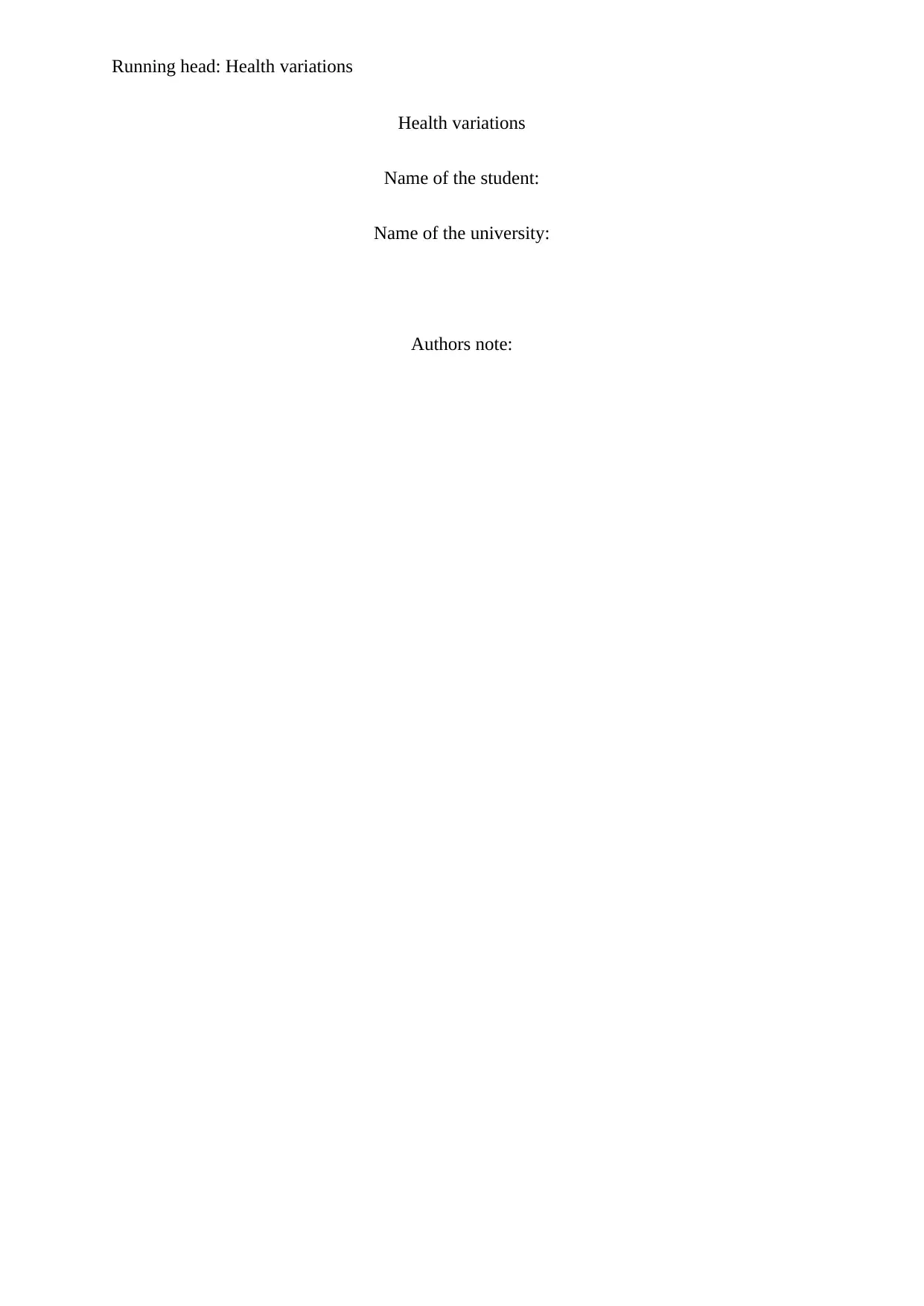
Running head: Health variations
Health variations
Name of the student:
Name of the university:
Authors note:
Health variations
Name of the student:
Name of the university:
Authors note:
Paraphrase This Document
Need a fresh take? Get an instant paraphrase of this document with our AI Paraphraser
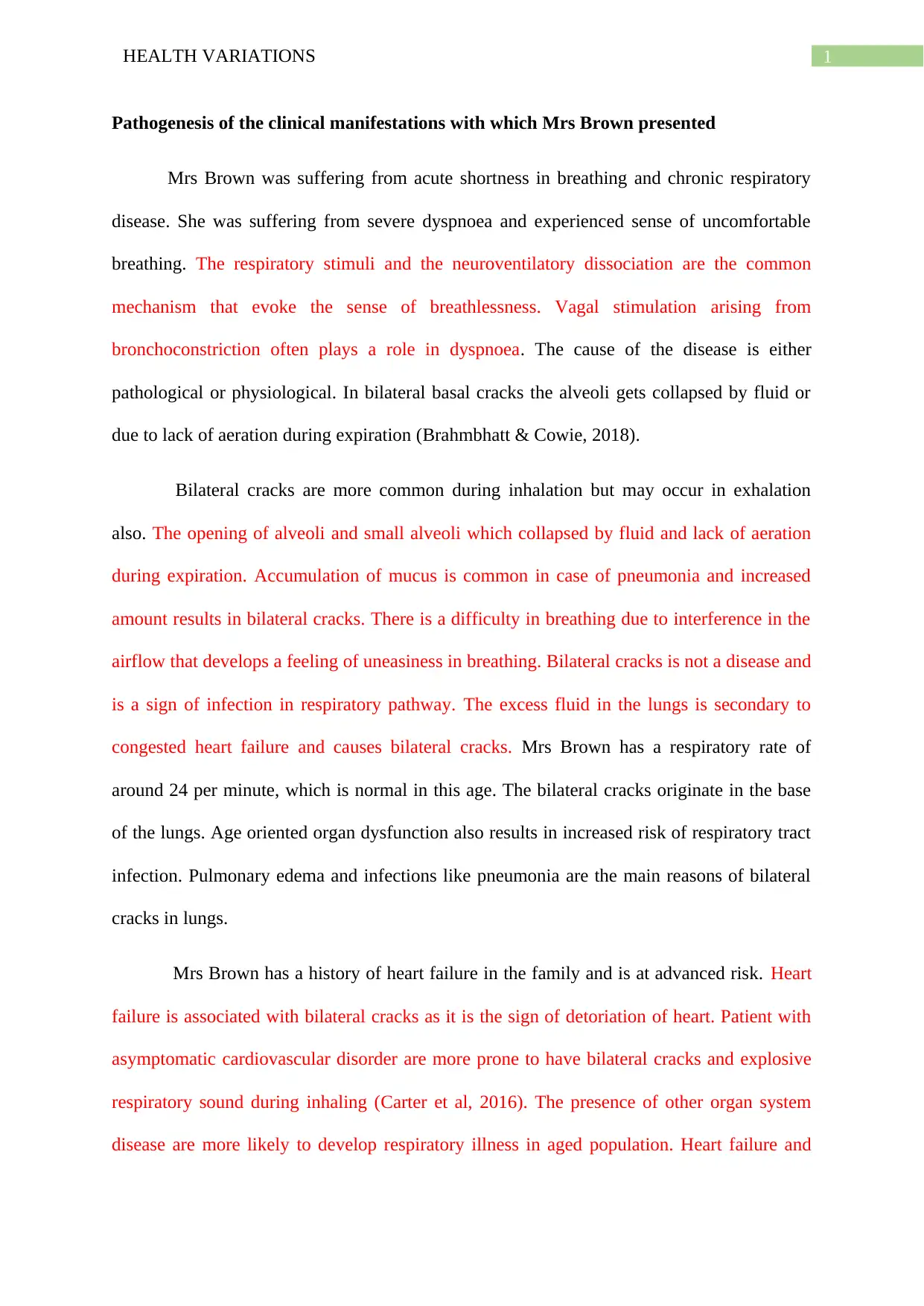
1HEALTH VARIATIONS
Pathogenesis of the clinical manifestations with which Mrs Brown presented
Mrs Brown was suffering from acute shortness in breathing and chronic respiratory
disease. She was suffering from severe dyspnoea and experienced sense of uncomfortable
breathing. The respiratory stimuli and the neuroventilatory dissociation are the common
mechanism that evoke the sense of breathlessness. Vagal stimulation arising from
bronchoconstriction often plays a role in dyspnoea. The cause of the disease is either
pathological or physiological. In bilateral basal cracks the alveoli gets collapsed by fluid or
due to lack of aeration during expiration (Brahmbhatt & Cowie, 2018).
Bilateral cracks are more common during inhalation but may occur in exhalation
also. The opening of alveoli and small alveoli which collapsed by fluid and lack of aeration
during expiration. Accumulation of mucus is common in case of pneumonia and increased
amount results in bilateral cracks. There is a difficulty in breathing due to interference in the
airflow that develops a feeling of uneasiness in breathing. Bilateral cracks is not a disease and
is a sign of infection in respiratory pathway. The excess fluid in the lungs is secondary to
congested heart failure and causes bilateral cracks. Mrs Brown has a respiratory rate of
around 24 per minute, which is normal in this age. The bilateral cracks originate in the base
of the lungs. Age oriented organ dysfunction also results in increased risk of respiratory tract
infection. Pulmonary edema and infections like pneumonia are the main reasons of bilateral
cracks in lungs.
Mrs Brown has a history of heart failure in the family and is at advanced risk. Heart
failure is associated with bilateral cracks as it is the sign of detoriation of heart. Patient with
asymptomatic cardiovascular disorder are more prone to have bilateral cracks and explosive
respiratory sound during inhaling (Carter et al, 2016). The presence of other organ system
disease are more likely to develop respiratory illness in aged population. Heart failure and
Pathogenesis of the clinical manifestations with which Mrs Brown presented
Mrs Brown was suffering from acute shortness in breathing and chronic respiratory
disease. She was suffering from severe dyspnoea and experienced sense of uncomfortable
breathing. The respiratory stimuli and the neuroventilatory dissociation are the common
mechanism that evoke the sense of breathlessness. Vagal stimulation arising from
bronchoconstriction often plays a role in dyspnoea. The cause of the disease is either
pathological or physiological. In bilateral basal cracks the alveoli gets collapsed by fluid or
due to lack of aeration during expiration (Brahmbhatt & Cowie, 2018).
Bilateral cracks are more common during inhalation but may occur in exhalation
also. The opening of alveoli and small alveoli which collapsed by fluid and lack of aeration
during expiration. Accumulation of mucus is common in case of pneumonia and increased
amount results in bilateral cracks. There is a difficulty in breathing due to interference in the
airflow that develops a feeling of uneasiness in breathing. Bilateral cracks is not a disease and
is a sign of infection in respiratory pathway. The excess fluid in the lungs is secondary to
congested heart failure and causes bilateral cracks. Mrs Brown has a respiratory rate of
around 24 per minute, which is normal in this age. The bilateral cracks originate in the base
of the lungs. Age oriented organ dysfunction also results in increased risk of respiratory tract
infection. Pulmonary edema and infections like pneumonia are the main reasons of bilateral
cracks in lungs.
Mrs Brown has a history of heart failure in the family and is at advanced risk. Heart
failure is associated with bilateral cracks as it is the sign of detoriation of heart. Patient with
asymptomatic cardiovascular disorder are more prone to have bilateral cracks and explosive
respiratory sound during inhaling (Carter et al, 2016). The presence of other organ system
disease are more likely to develop respiratory illness in aged population. Heart failure and
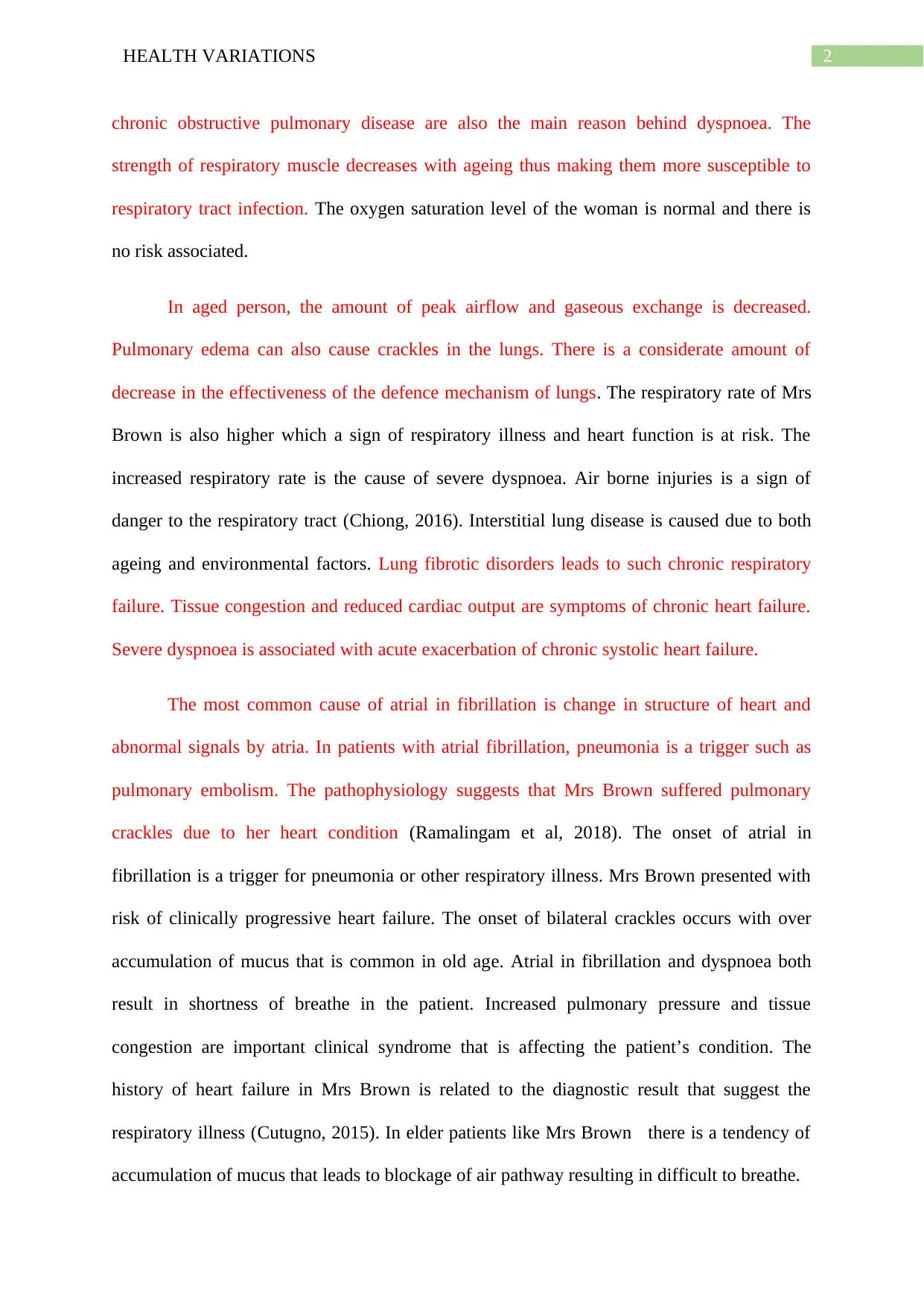
2HEALTH VARIATIONS
chronic obstructive pulmonary disease are also the main reason behind dyspnoea. The
strength of respiratory muscle decreases with ageing thus making them more susceptible to
respiratory tract infection. The oxygen saturation level of the woman is normal and there is
no risk associated.
In aged person, the amount of peak airflow and gaseous exchange is decreased.
Pulmonary edema can also cause crackles in the lungs. There is a considerate amount of
decrease in the effectiveness of the defence mechanism of lungs. The respiratory rate of Mrs
Brown is also higher which a sign of respiratory illness and heart function is at risk. The
increased respiratory rate is the cause of severe dyspnoea. Air borne injuries is a sign of
danger to the respiratory tract (Chiong, 2016). Interstitial lung disease is caused due to both
ageing and environmental factors. Lung fibrotic disorders leads to such chronic respiratory
failure. Tissue congestion and reduced cardiac output are symptoms of chronic heart failure.
Severe dyspnoea is associated with acute exacerbation of chronic systolic heart failure.
The most common cause of atrial in fibrillation is change in structure of heart and
abnormal signals by atria. In patients with atrial fibrillation, pneumonia is a trigger such as
pulmonary embolism. The pathophysiology suggests that Mrs Brown suffered pulmonary
crackles due to her heart condition (Ramalingam et al, 2018). The onset of atrial in
fibrillation is a trigger for pneumonia or other respiratory illness. Mrs Brown presented with
risk of clinically progressive heart failure. The onset of bilateral crackles occurs with over
accumulation of mucus that is common in old age. Atrial in fibrillation and dyspnoea both
result in shortness of breathe in the patient. Increased pulmonary pressure and tissue
congestion are important clinical syndrome that is affecting the patient’s condition. The
history of heart failure in Mrs Brown is related to the diagnostic result that suggest the
respiratory illness (Cutugno, 2015). In elder patients like Mrs Brown there is a tendency of
accumulation of mucus that leads to blockage of air pathway resulting in difficult to breathe.
chronic obstructive pulmonary disease are also the main reason behind dyspnoea. The
strength of respiratory muscle decreases with ageing thus making them more susceptible to
respiratory tract infection. The oxygen saturation level of the woman is normal and there is
no risk associated.
In aged person, the amount of peak airflow and gaseous exchange is decreased.
Pulmonary edema can also cause crackles in the lungs. There is a considerate amount of
decrease in the effectiveness of the defence mechanism of lungs. The respiratory rate of Mrs
Brown is also higher which a sign of respiratory illness and heart function is at risk. The
increased respiratory rate is the cause of severe dyspnoea. Air borne injuries is a sign of
danger to the respiratory tract (Chiong, 2016). Interstitial lung disease is caused due to both
ageing and environmental factors. Lung fibrotic disorders leads to such chronic respiratory
failure. Tissue congestion and reduced cardiac output are symptoms of chronic heart failure.
Severe dyspnoea is associated with acute exacerbation of chronic systolic heart failure.
The most common cause of atrial in fibrillation is change in structure of heart and
abnormal signals by atria. In patients with atrial fibrillation, pneumonia is a trigger such as
pulmonary embolism. The pathophysiology suggests that Mrs Brown suffered pulmonary
crackles due to her heart condition (Ramalingam et al, 2018). The onset of atrial in
fibrillation is a trigger for pneumonia or other respiratory illness. Mrs Brown presented with
risk of clinically progressive heart failure. The onset of bilateral crackles occurs with over
accumulation of mucus that is common in old age. Atrial in fibrillation and dyspnoea both
result in shortness of breathe in the patient. Increased pulmonary pressure and tissue
congestion are important clinical syndrome that is affecting the patient’s condition. The
history of heart failure in Mrs Brown is related to the diagnostic result that suggest the
respiratory illness (Cutugno, 2015). In elder patients like Mrs Brown there is a tendency of
accumulation of mucus that leads to blockage of air pathway resulting in difficult to breathe.
⊘ This is a preview!⊘
Do you want full access?
Subscribe today to unlock all pages.

Trusted by 1+ million students worldwide
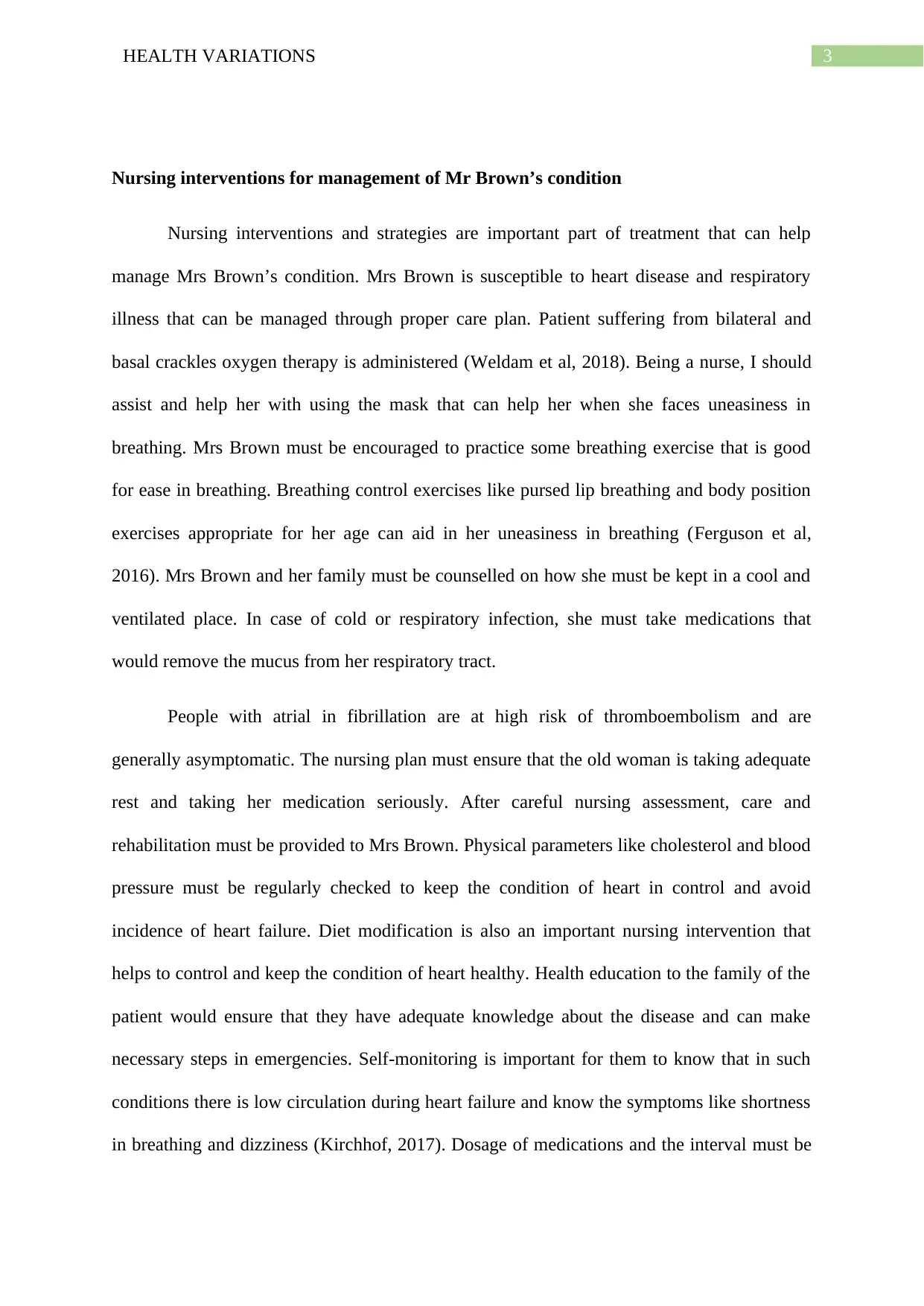
3HEALTH VARIATIONS
Nursing interventions for management of Mr Brown’s condition
Nursing interventions and strategies are important part of treatment that can help
manage Mrs Brown’s condition. Mrs Brown is susceptible to heart disease and respiratory
illness that can be managed through proper care plan. Patient suffering from bilateral and
basal crackles oxygen therapy is administered (Weldam et al, 2018). Being a nurse, I should
assist and help her with using the mask that can help her when she faces uneasiness in
breathing. Mrs Brown must be encouraged to practice some breathing exercise that is good
for ease in breathing. Breathing control exercises like pursed lip breathing and body position
exercises appropriate for her age can aid in her uneasiness in breathing (Ferguson et al,
2016). Mrs Brown and her family must be counselled on how she must be kept in a cool and
ventilated place. In case of cold or respiratory infection, she must take medications that
would remove the mucus from her respiratory tract.
People with atrial in fibrillation are at high risk of thromboembolism and are
generally asymptomatic. The nursing plan must ensure that the old woman is taking adequate
rest and taking her medication seriously. After careful nursing assessment, care and
rehabilitation must be provided to Mrs Brown. Physical parameters like cholesterol and blood
pressure must be regularly checked to keep the condition of heart in control and avoid
incidence of heart failure. Diet modification is also an important nursing intervention that
helps to control and keep the condition of heart healthy. Health education to the family of the
patient would ensure that they have adequate knowledge about the disease and can make
necessary steps in emergencies. Self-monitoring is important for them to know that in such
conditions there is low circulation during heart failure and know the symptoms like shortness
in breathing and dizziness (Kirchhof, 2017). Dosage of medications and the interval must be
Nursing interventions for management of Mr Brown’s condition
Nursing interventions and strategies are important part of treatment that can help
manage Mrs Brown’s condition. Mrs Brown is susceptible to heart disease and respiratory
illness that can be managed through proper care plan. Patient suffering from bilateral and
basal crackles oxygen therapy is administered (Weldam et al, 2018). Being a nurse, I should
assist and help her with using the mask that can help her when she faces uneasiness in
breathing. Mrs Brown must be encouraged to practice some breathing exercise that is good
for ease in breathing. Breathing control exercises like pursed lip breathing and body position
exercises appropriate for her age can aid in her uneasiness in breathing (Ferguson et al,
2016). Mrs Brown and her family must be counselled on how she must be kept in a cool and
ventilated place. In case of cold or respiratory infection, she must take medications that
would remove the mucus from her respiratory tract.
People with atrial in fibrillation are at high risk of thromboembolism and are
generally asymptomatic. The nursing plan must ensure that the old woman is taking adequate
rest and taking her medication seriously. After careful nursing assessment, care and
rehabilitation must be provided to Mrs Brown. Physical parameters like cholesterol and blood
pressure must be regularly checked to keep the condition of heart in control and avoid
incidence of heart failure. Diet modification is also an important nursing intervention that
helps to control and keep the condition of heart healthy. Health education to the family of the
patient would ensure that they have adequate knowledge about the disease and can make
necessary steps in emergencies. Self-monitoring is important for them to know that in such
conditions there is low circulation during heart failure and know the symptoms like shortness
in breathing and dizziness (Kirchhof, 2017). Dosage of medications and the interval must be
Paraphrase This Document
Need a fresh take? Get an instant paraphrase of this document with our AI Paraphraser
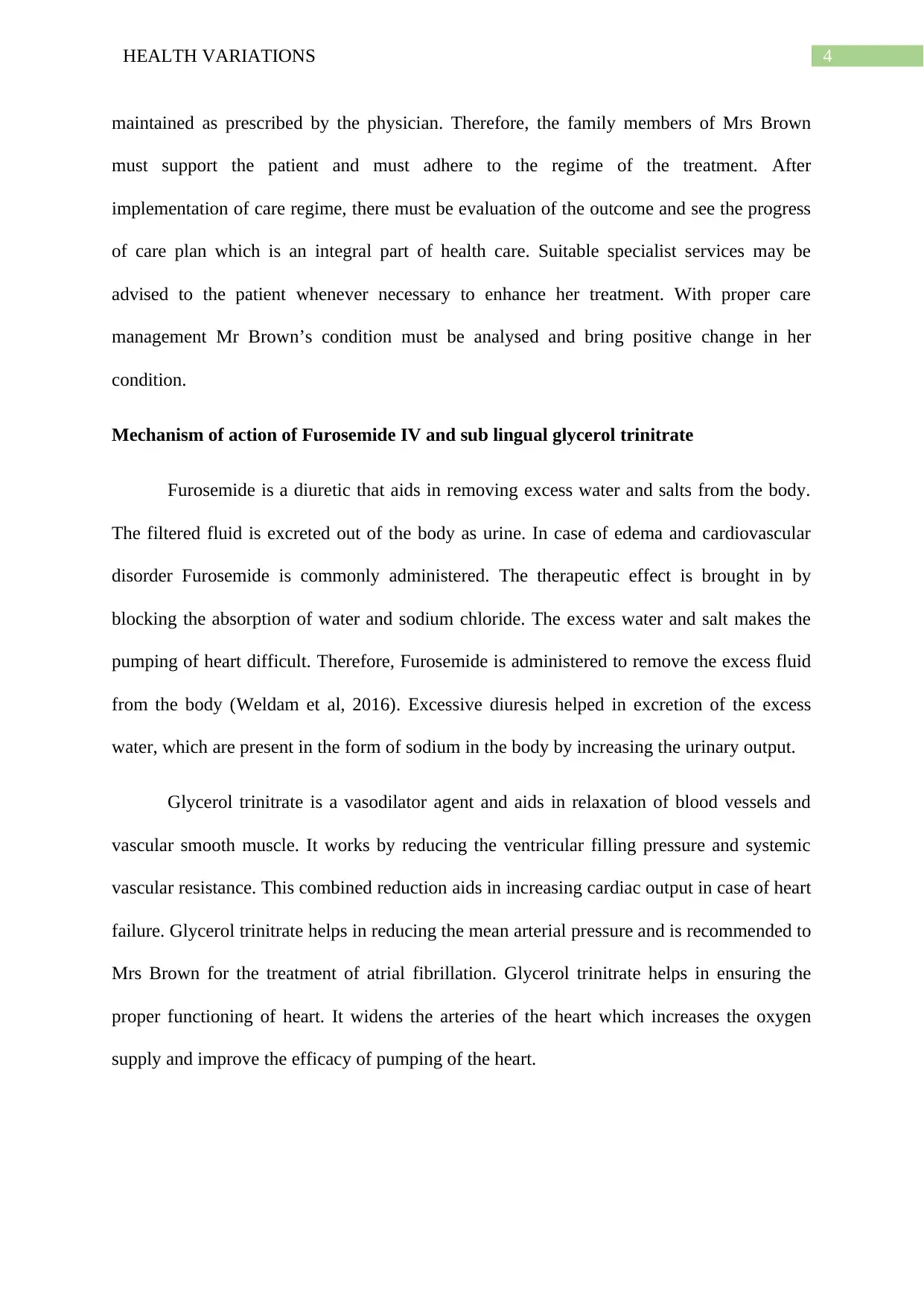
4HEALTH VARIATIONS
maintained as prescribed by the physician. Therefore, the family members of Mrs Brown
must support the patient and must adhere to the regime of the treatment. After
implementation of care regime, there must be evaluation of the outcome and see the progress
of care plan which is an integral part of health care. Suitable specialist services may be
advised to the patient whenever necessary to enhance her treatment. With proper care
management Mr Brown’s condition must be analysed and bring positive change in her
condition.
Mechanism of action of Furosemide IV and sub lingual glycerol trinitrate
Furosemide is a diuretic that aids in removing excess water and salts from the body.
The filtered fluid is excreted out of the body as urine. In case of edema and cardiovascular
disorder Furosemide is commonly administered. The therapeutic effect is brought in by
blocking the absorption of water and sodium chloride. The excess water and salt makes the
pumping of heart difficult. Therefore, Furosemide is administered to remove the excess fluid
from the body (Weldam et al, 2016). Excessive diuresis helped in excretion of the excess
water, which are present in the form of sodium in the body by increasing the urinary output.
Glycerol trinitrate is a vasodilator agent and aids in relaxation of blood vessels and
vascular smooth muscle. It works by reducing the ventricular filling pressure and systemic
vascular resistance. This combined reduction aids in increasing cardiac output in case of heart
failure. Glycerol trinitrate helps in reducing the mean arterial pressure and is recommended to
Mrs Brown for the treatment of atrial fibrillation. Glycerol trinitrate helps in ensuring the
proper functioning of heart. It widens the arteries of the heart which increases the oxygen
supply and improve the efficacy of pumping of the heart.
maintained as prescribed by the physician. Therefore, the family members of Mrs Brown
must support the patient and must adhere to the regime of the treatment. After
implementation of care regime, there must be evaluation of the outcome and see the progress
of care plan which is an integral part of health care. Suitable specialist services may be
advised to the patient whenever necessary to enhance her treatment. With proper care
management Mr Brown’s condition must be analysed and bring positive change in her
condition.
Mechanism of action of Furosemide IV and sub lingual glycerol trinitrate
Furosemide is a diuretic that aids in removing excess water and salts from the body.
The filtered fluid is excreted out of the body as urine. In case of edema and cardiovascular
disorder Furosemide is commonly administered. The therapeutic effect is brought in by
blocking the absorption of water and sodium chloride. The excess water and salt makes the
pumping of heart difficult. Therefore, Furosemide is administered to remove the excess fluid
from the body (Weldam et al, 2016). Excessive diuresis helped in excretion of the excess
water, which are present in the form of sodium in the body by increasing the urinary output.
Glycerol trinitrate is a vasodilator agent and aids in relaxation of blood vessels and
vascular smooth muscle. It works by reducing the ventricular filling pressure and systemic
vascular resistance. This combined reduction aids in increasing cardiac output in case of heart
failure. Glycerol trinitrate helps in reducing the mean arterial pressure and is recommended to
Mrs Brown for the treatment of atrial fibrillation. Glycerol trinitrate helps in ensuring the
proper functioning of heart. It widens the arteries of the heart which increases the oxygen
supply and improve the efficacy of pumping of the heart.
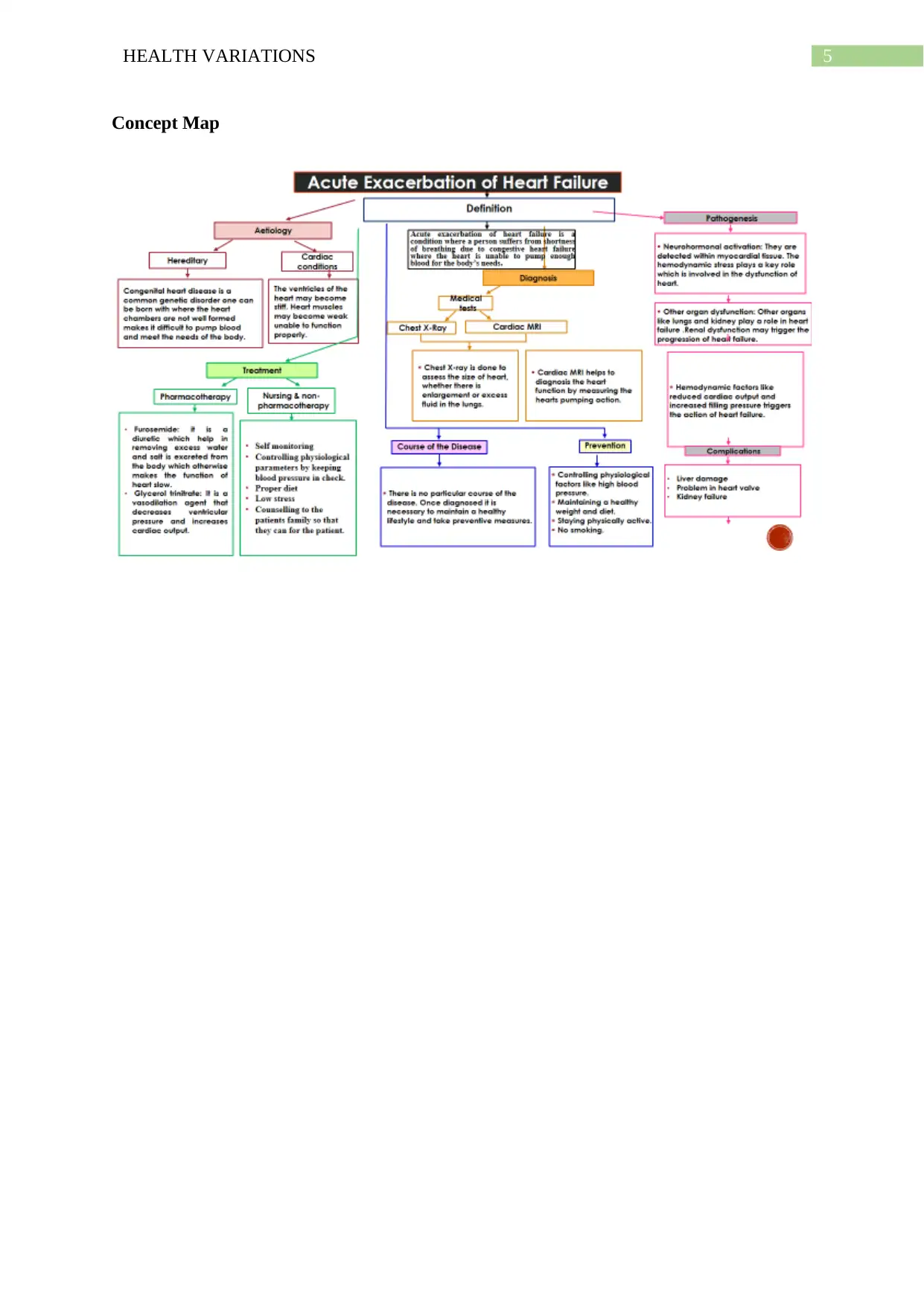
5HEALTH VARIATIONS
Concept Map
Concept Map
⊘ This is a preview!⊘
Do you want full access?
Subscribe today to unlock all pages.

Trusted by 1+ million students worldwide
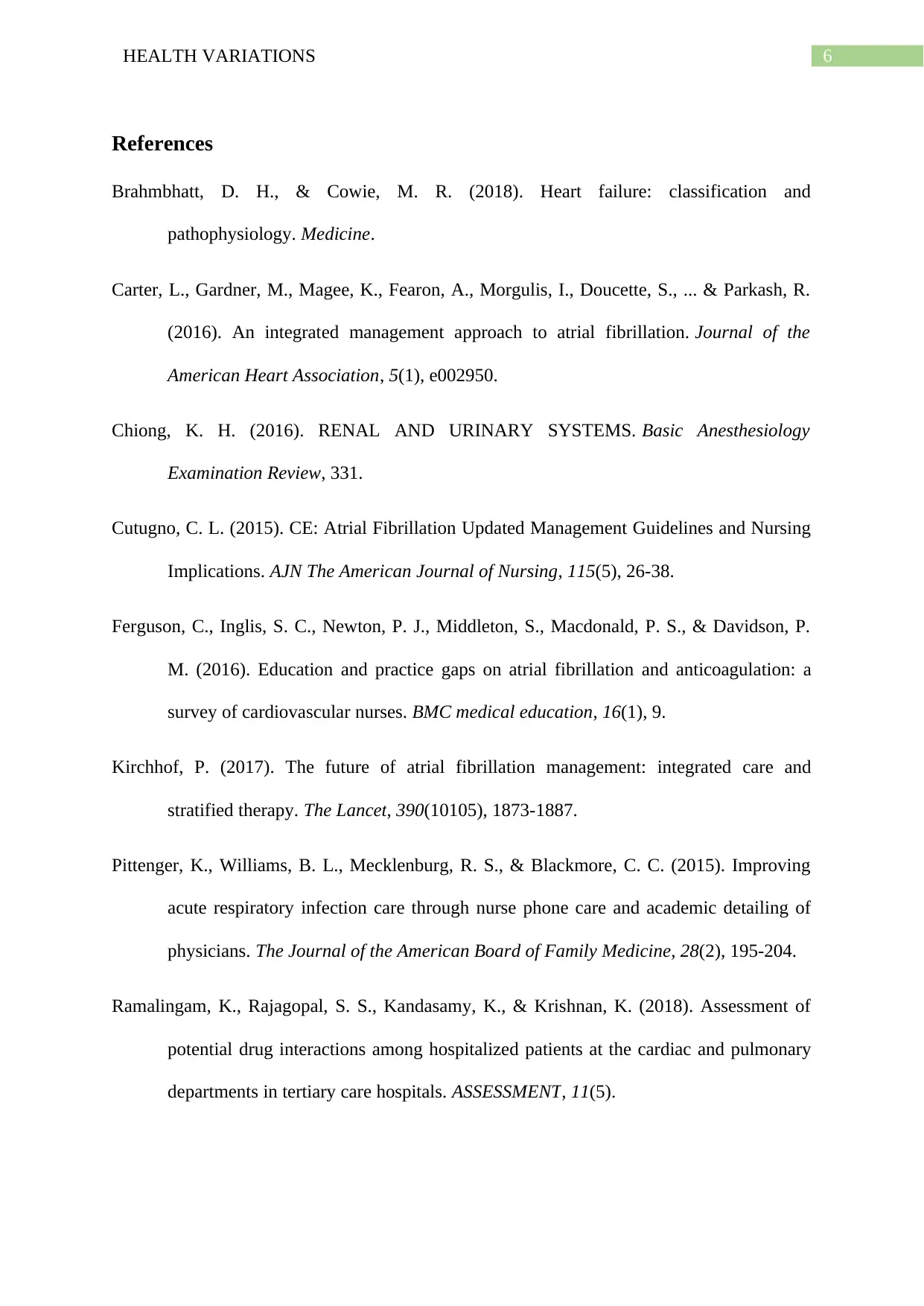
6HEALTH VARIATIONS
References
Brahmbhatt, D. H., & Cowie, M. R. (2018). Heart failure: classification and
pathophysiology. Medicine.
Carter, L., Gardner, M., Magee, K., Fearon, A., Morgulis, I., Doucette, S., ... & Parkash, R.
(2016). An integrated management approach to atrial fibrillation. Journal of the
American Heart Association, 5(1), e002950.
Chiong, K. H. (2016). RENAL AND URINARY SYSTEMS. Basic Anesthesiology
Examination Review, 331.
Cutugno, C. L. (2015). CE: Atrial Fibrillation Updated Management Guidelines and Nursing
Implications. AJN The American Journal of Nursing, 115(5), 26-38.
Ferguson, C., Inglis, S. C., Newton, P. J., Middleton, S., Macdonald, P. S., & Davidson, P.
M. (2016). Education and practice gaps on atrial fibrillation and anticoagulation: a
survey of cardiovascular nurses. BMC medical education, 16(1), 9.
Kirchhof, P. (2017). The future of atrial fibrillation management: integrated care and
stratified therapy. The Lancet, 390(10105), 1873-1887.
Pittenger, K., Williams, B. L., Mecklenburg, R. S., & Blackmore, C. C. (2015). Improving
acute respiratory infection care through nurse phone care and academic detailing of
physicians. The Journal of the American Board of Family Medicine, 28(2), 195-204.
Ramalingam, K., Rajagopal, S. S., Kandasamy, K., & Krishnan, K. (2018). Assessment of
potential drug interactions among hospitalized patients at the cardiac and pulmonary
departments in tertiary care hospitals. ASSESSMENT, 11(5).
References
Brahmbhatt, D. H., & Cowie, M. R. (2018). Heart failure: classification and
pathophysiology. Medicine.
Carter, L., Gardner, M., Magee, K., Fearon, A., Morgulis, I., Doucette, S., ... & Parkash, R.
(2016). An integrated management approach to atrial fibrillation. Journal of the
American Heart Association, 5(1), e002950.
Chiong, K. H. (2016). RENAL AND URINARY SYSTEMS. Basic Anesthesiology
Examination Review, 331.
Cutugno, C. L. (2015). CE: Atrial Fibrillation Updated Management Guidelines and Nursing
Implications. AJN The American Journal of Nursing, 115(5), 26-38.
Ferguson, C., Inglis, S. C., Newton, P. J., Middleton, S., Macdonald, P. S., & Davidson, P.
M. (2016). Education and practice gaps on atrial fibrillation and anticoagulation: a
survey of cardiovascular nurses. BMC medical education, 16(1), 9.
Kirchhof, P. (2017). The future of atrial fibrillation management: integrated care and
stratified therapy. The Lancet, 390(10105), 1873-1887.
Pittenger, K., Williams, B. L., Mecklenburg, R. S., & Blackmore, C. C. (2015). Improving
acute respiratory infection care through nurse phone care and academic detailing of
physicians. The Journal of the American Board of Family Medicine, 28(2), 195-204.
Ramalingam, K., Rajagopal, S. S., Kandasamy, K., & Krishnan, K. (2018). Assessment of
potential drug interactions among hospitalized patients at the cardiac and pulmonary
departments in tertiary care hospitals. ASSESSMENT, 11(5).
Paraphrase This Document
Need a fresh take? Get an instant paraphrase of this document with our AI Paraphraser
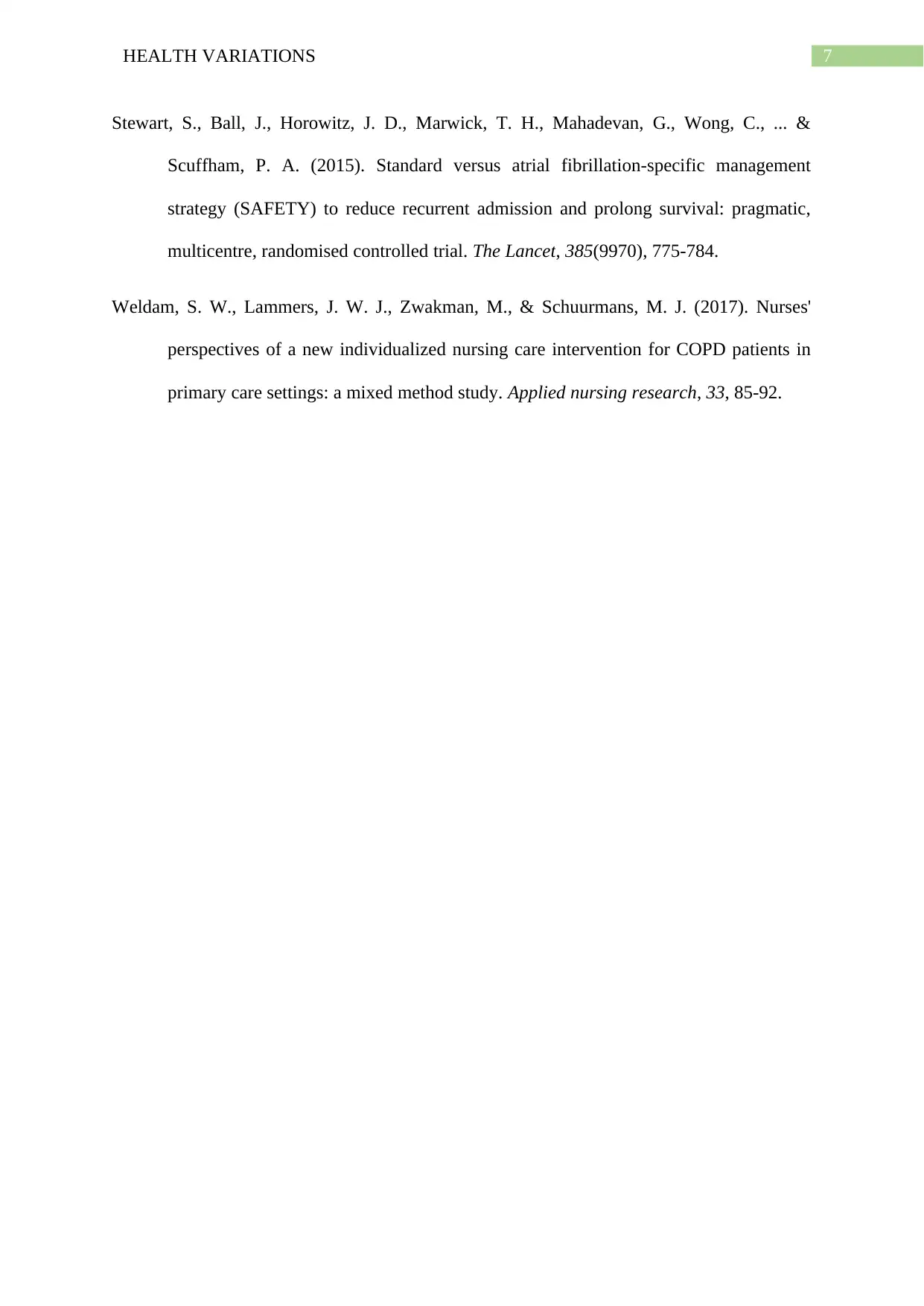
7HEALTH VARIATIONS
Stewart, S., Ball, J., Horowitz, J. D., Marwick, T. H., Mahadevan, G., Wong, C., ... &
Scuffham, P. A. (2015). Standard versus atrial fibrillation-specific management
strategy (SAFETY) to reduce recurrent admission and prolong survival: pragmatic,
multicentre, randomised controlled trial. The Lancet, 385(9970), 775-784.
Weldam, S. W., Lammers, J. W. J., Zwakman, M., & Schuurmans, M. J. (2017). Nurses'
perspectives of a new individualized nursing care intervention for COPD patients in
primary care settings: a mixed method study. Applied nursing research, 33, 85-92.
Stewart, S., Ball, J., Horowitz, J. D., Marwick, T. H., Mahadevan, G., Wong, C., ... &
Scuffham, P. A. (2015). Standard versus atrial fibrillation-specific management
strategy (SAFETY) to reduce recurrent admission and prolong survival: pragmatic,
multicentre, randomised controlled trial. The Lancet, 385(9970), 775-784.
Weldam, S. W., Lammers, J. W. J., Zwakman, M., & Schuurmans, M. J. (2017). Nurses'
perspectives of a new individualized nursing care intervention for COPD patients in
primary care settings: a mixed method study. Applied nursing research, 33, 85-92.
1 out of 8
Related Documents
Your All-in-One AI-Powered Toolkit for Academic Success.
+13062052269
info@desklib.com
Available 24*7 on WhatsApp / Email
![[object Object]](/_next/static/media/star-bottom.7253800d.svg)
Unlock your academic potential
Copyright © 2020–2025 A2Z Services. All Rights Reserved. Developed and managed by ZUCOL.




